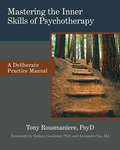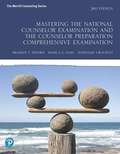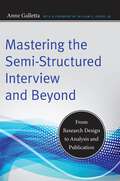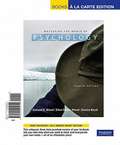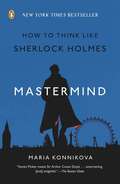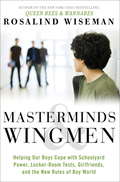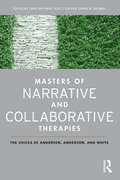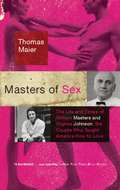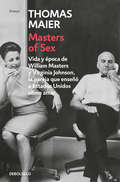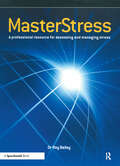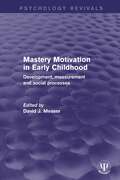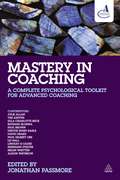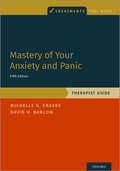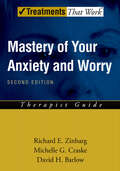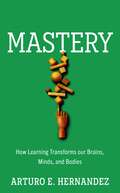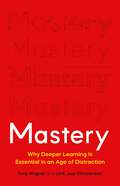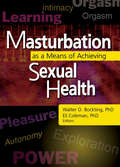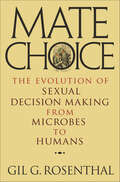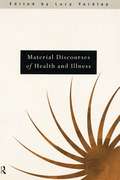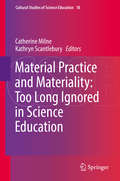- Table View
- List View
Mastering the Inner Skills of Psychotherapy: A Deliberate Practice Manual
by PsyD Tony RousmaniereDo you ever find that you are less effective with clients who are provocative, angry, shut down, or emotionally labile? Would you like to be more effective helping clients with challenging problems, including trauma, addictions, and comorbid conditions? Clients can arouse strong emotional reactions in therapists, often termed experiential avoidance or countertransference. To be effective with these challenging cases, therapists must build their psychological capacity to stay self-aware, attuned, and clinically flexible while having strong reactions. This manual provides clear and practical deliberate practice exercises to help you master these inner skills so you can be a more effective therapist and enjoy your work more. This manual features a training plan that is based on the principles of deliberate practice, works with all major models of psychotherapy, aids all levels of therapist development, from beginning trainees to experienced clinicians, helps therapists be more effective with their most challenging clients, and protects the boundaries and privacy of trainees. Louis G. Castonguay, Professor, at Penn State University, said the book "is an innovative addition to the movement of deliberate practice," and that "this book offers troves of ideas, tools, and resources for therapists of varied theoretical orientations and experience levels." Catherine Eubanks, president-elect of the society for the Exploration of Psychotherapy Integration, commented that "by practical techniques for increasing therapists’ capacity to be present and attuned in the therapy session, Rousmaniere draws attention to one of the most important ways to advance our field and improve our ability to help our patients."
Mastering the National Counselor Examination and the Counselor Preparation Comprehensive Examination
by Danica G. Hays Bradley T. Erford Stephanie CrockettThis book is specifically designed to help students preparing for the NCE or CPCE and professional counselors preparing to take the NCE as a licensure exam. This practical guide provides numerous sample questions, includes four full-length practice exams – two for the NCE and two for the CPCE – and presents pertinent information about the NCE and CPCE, including discussion of its rationale, structure, format, and scoring procedures. Readers have ample opportunities to test their knowledge and practice answering the types of questions that they will encounter on the exams. Fully updated to align with 2016 CACREP standards and current NCE/CPCE content, the 3rd Edition includes new test preparation items, additional case studies, and a revised glossary of key terms. An updated Chapter 1 includes test-taking strategies, and a revised Chapter 9 focuses on what future counselors need to know about getting a job and marketing themselves as professional counselors.
Mastering the Semi-Structured Interview and Beyond: From Research Design to Analysis and Publication (Qualitative Studies in Psychology #18)
by Anne GallettaMastering the Semi-Structured Interview and Beyond offers an in-depth and captivating step-by-step guide to the use of semi-structured interviews in qualitative research. By tracing the life of an actual research project–an exploration of a school district's effort over 40 years to address racial equality–as a consistent example threaded across the volume, Anne Galletta shows in concrete terms how readers can approach the planning and execution of their own new research endeavor, and illuminates unexpected real-life challenges they may confront and how to address them. The volume offers a close look at the inductive nature of qualitative research, the use of researcher reflexivity, and the systematic and iterative steps involved in data collection, analysis, and interpretation. It offers guidance on how to develop an interview protocol, including the arrangement of questions and ways to evoke analytically rich data. Particularly useful for those who may be familiar with qualitative research but have not yet conducted a qualitative study, Mastering the Semi-Structured Interview and Beyond will serve both undergraduate and graduate students as well as more advanced scholars seeking to incorporate this key methodological approach into their repertoire.
Mastering the World of Psychology (4th Edition)
by Samuel E. Wood Ellen Green Wood Denise BoydMastering the World of Psychology is a brief, paperback text focused on supplying the most support for student learning and student success. It makes the connection between scientific principles and the everyday lives of today's diverse student population.
Mastermind: How to Think Like Sherlock Holmes
by Maria KonnikovaFrom the author of The Confidence Game (January 2016), The New York Times bestselling guide to thinking like literature's greatest detective No fictional character is more renowned for his powers of thought and observation than Sherlock Holmes. But is his extraordinary intellect merely a gift of fiction, or can we learn to cultivate these abilities ourselves, to improve our lives at work and at home? We can, says psychologist and journalist Maria Konnikova, and in Mastermind she shows us how. Beginning with the "brain attic"--Holmes's metaphor for how we store information and organize knowledge--Konnikova unpacks the mental strategies that lead to clearer thinking and deeper insights. Drawing on twenty-first-century neuroscience and psychology, Mastermind explores Holmes's unique methods of ever-present mindfulness, astute observation, and logical deduction. In doing so, it shows how each of us, with some self-awareness and a little practice, can employ these same methods to sharpen our perceptions, solve difficult problems, and enhance our creative powers. For Holmes aficionados and casual readers alike, Konnikova reveals how the world's most keen-eyed detective can serve as an unparalleled guide to upgrading the mind.From the Hardcover edition.
Masterminds and Wingmen
by Rosalind WisemanHere is a landmark book that reveals the way boys think and that shows parents, educators and coaches how to reach out and help boys overcome their most common yet difficult challenges -- by the bestselling author who changed our conception of adolescent girls. Do you constantly struggle to pull information from your son, student, or athlete, only to encounter mumbling or evasive assurances such as "It's nothing" or "I'm good?" Do you sense that the boy you care about is being bullied, but that he'll do anything to avoid your "help?" Have you repeatedly reminded him that schoolwork and chores come before video games only to spy him reaching for the controller as soon as you leave the room? Have you watched with frustration as your boy flounders with girls? Welcome to Boy World. It's a place where asking for help or showing emotional pain often feels impossible. Where sports and video games can mean everything, but working hard in school frequently earns ridicule from "the guys" even as they ask to copy assignments. Where "masterminds" dominate and friends ruthlessly insult each other but can never object when someone steps over the line. Where hiding problems from adults is the ironclad rule because their involvement only makes situations worse. Boy world is governed by social hierarchies and a powerful set of unwritten rules that have huge implications for your boy's relationships, his interactions with you, and the man he'll become. If you want what's best for him, you need to know what these rules are and how to work with them effectively. What you'll find in Masterminds and Wingmen is critically important for every parent - or anyone who cares about boys - to know. Collaborating with a large team of middle- and high-school-age editors, Rosalind Wiseman has created an unprecedented guide to the life your boy is actually experiencing - his on-the-ground reality. Not only does Wiseman challenge you to examine your assumptions, she offers innovative coping strategies aimed at helping your boy develop a positive, authentic, and strong sense of self.
Masters of Narrative and Collaborative Therapies: The Voices of Andersen, Anderson, and White
by White Anderson AndersenTom Andersen, Harlene Anderson, and Michael White have shaped the landscapes of dialogical, collaborative, and narrative therapies. This unique book archives one of their gatherings and, in the spirit of therapeutic practice, is conversational and captures the presentations and exchanges between the three main contributors and international discussants. Tom Andersen invites us along to navigate the ‘forks in the road’ he faced in his emerging career, and he revisits the development of his pioneering ideas such as reflecting teams. Harlene Anderson paints the picture of her experiences in collaboration with women in Bosnia. Michael White, co-founder of the narrative therapy tradition, then provides a clear example of the frontiers of collaborative post-modern therapies. Through the introduction of the theory and application of Vygotskian ideas Michael excites the reader about what is possible to know and do in a therapeutic conversation.
Masters of Sex
by Thomas MaierIn Masters of Sex, critically acclaimed biographer Thomas Maier offers an unprecedented look at William Masters and Virginia Johnson, their pioneering studies of intimacy, and the sexual revolution they inspired. Masters and Johnson began their secret studies in a small Midwest laboratory, and soon became the nation’s top experts on sex. Over the course of more than forty years, they analyzed and explained the secrets of orgasm, emotional fulfillment, and sexual dysfunction. But they divorced after twenty years amid a clash of success, betrayal, and jealousies. Weaving interviews with the notoriously private William Masters and the ambitious Virginia Johnson, Maier offers a titillating portrait of the legendary couple. Entertaining, revealing, and beautifully told, this groundbreaking book sheds light on the eternal mysteries of desire and intimacy, and their complicated roles in the American psyche.
Masters of Sex
by Thomas MaierIn Masters of Sex, critically acclaimed biographer Thomas Maier offers an unprecedented look at William Masters and Virginia Johnson, their pioneering studies of intimacy, and the sexual revolution they inspired. Masters and Johnson began their secret studies in a small Midwest laboratory, and soon became the nation's top experts on sex. Over the course of more than forty years, they analyzed and explained the secrets of orgasm, emotional fulfillment, and sexual dysfunction. But they divorced after twenty years amid a clash of success, betrayal, and jealousies.Weaving interviews with the notoriously private William Masters and the ambitious Virginia Johnson, Maier offers a titillating portrait of the legendary couple. Entertaining, revealing, and beautifully told, this groundbreaking book sheds light on the eternal mysteries of desire and intimacy, and their complicated roles in the American psyche.
Masters of Sex
by Thomas MaierIn Masters of Sex, critically acclaimed biographer Thomas Maier offers an unprecedented look at William Masters and Virginia Johnson, their pioneering studies of intimacy, and the sexual revolution they inspired. Masters and Johnson began their secret studies in a small Midwest laboratory, and soon became the nation’s top experts on sex. Over the course of more than forty years, they analyzed and explained the secrets of orgasm, emotional fulfillment, and sexual dysfunction. But they divorced after twenty years amid a clash of success, betrayal, and jealousies. Weaving interviews with the notoriously private William Masters and the ambitious Virginia Johnson, Maier offers a titillating portrait of the legendary couple. Entertaining, revealing, and beautifully told, this groundbreaking book sheds light on the eternal mysteries of desire and intimacy, and their complicated roles in the American psyche.
Masters of Sex: The Life and Times of William Masters and Virginia Johnson, the Couple Who Taught America How to Love
by Thomas MaierNow a New Showtime Original Series Showtime's dramatic series Masters of Sex, starring Michael Sheen and Lizzy Caplan, is based on this real-life story of sex researchers William Masters and Virginia Johnson. Before Sex and the City and ViagraTM, America relied on Masters and Johnson to teach us everything we needed to know about what goes on in the bedroom. Convincing hundreds of men and women to shed their clothes and copulate, the pair were the nation’s top experts on love and intimacy. Highlighting interviews with the notoriously private Masters and the ambitious Johnson, critically acclaimed biographer Thomas Maier shows how this unusual team changed the way we all thought about, talked about, and engaged in sex while they simultaneously tried to make sense of their own relationship. Entertaining, revealing, and beautifully told, Masters of Sex sheds light on the eternal mysteries of desire, intimacy, and the American psyche.
Masters of Sex: Vida y época de William Masters y Virginia Johnson, la pareja que enseñó a Estados Unidos cómo amar
by Thomas MaierUn excitante retrato del ginecólogo William Masters y la sexóloga Virginia Johnson, la pareja que cambió la forma en que todos pensamos, hablamos y participamos del sexo. Las investigaciones del ginecólogo William Masters y la sexóloga Virginia Johnson supusieron toda una revolución en la década de los 60. A lo largo de más de cuarenta años, a través de la observación directa de miles de encuentros sexuales entre cientos de hombres y mujeres, analizaron y explicaron temas hasta entonces tabú como los secretos del orgasmo, la homosexualidad, la satisfacción emocional o la disfunción. Thomas Maier ofrece una mirada sin precedentes sobre la pareja que cambió la forma en que todos pensamos, hablamos y participamos del sexo. Reseñas:«Un relato perspicaz y bien escrito sobre Masters y Johnson, que, en un sentido clínico, probablemente sabían más sobre el sexo y el amor conyugal que cualquier otra pareja en Estados Unidos.»Gay Talese «Narrada con paciencia y esmero... Maier escribe bien, y con humor.»New York Times «Una mirada, maravillosamente escrita y totalmente absorbente, a una pareja increíble.»Booklist «El galardonado biógrafo Maier... ofrece el primer examen en profundidad de la compleja pareja que ayudó a revolucionar el estudio de la respuesta sexual humana.»Library Journal «La reveladora biografía de Maier se adentra en la vida de la pareja que inició la revolución sexual.»Discover «Absorbente. Masters of sex es un libro de lectura obligada para aquellos que quieran conocer los embriagadores comienzos de la revolución sexual.»The American Prospect «Puede que debido a su tórrido tema, Masters of sex [...] pueda impactar a algunos lectores por resultar extraordinariamente gráfico tratándose de una biografía, pero este perturbador relato de sexo y ciencia en la teoría y la práctica es en realidad más aleccionador que excitanteO, The Oprah Magazine
Masters of sex
by Thomas MaierThe definitive biography of the famous sex research team who dramatically transformed American sexuality yet whose private relationship was just as complex and dysfunctional as any of their patients
Masterstress: A Professional Resource for Assessing and Managing Stress
by Roy BaileyThis is a comprehensive professional resource for assessing stress and delivering stress management interventions. This is an extensive resource for health practitioners to: select the most appropriate stress assessment and stress management interventions for their clients; enable their clients to engage in effective personal stress management; and, empower clients to become more self-managing and, through their own efforts, manage unwanted stress. This is an essential resource for all counsellors and therapists working with individuals or groups suffering from stress and maladaptive coping. Organised to suit busy professionals, it provides a clear knowledge base of stress, as well as a photocopiable resource of stress management interventions.
Mastery Motivation in Early Childhood: Development, Measurement and Social Processes (Psychology Revivals)
by David J. MesserAll children possess a motive to ‘master’ the various tasks and problems that they face. Without mastery motivation, it is doubtful whether children would make progress in cognitive, social communicative and other domains. Although all children possess this motivation, it will vary according to inherited dispositions and to environmental experiences. This makes mastery motivation a key factor in understanding later developmental and educational achievement. Concentrating on pre-school children, this volume, originally published in 1993, brought together current research work and thinking concerned with mastery motivation at the time. New ideas are presented about the way mastery is related to other developmental processes such as self-concepts and attention. There are discussions and findings about innovations in the methods of assessing mastery. Another important theme present in this volume, is the way in which features of social interaction, attachment and the environment influence the development of mastery motivation. With a broad range of international contributors, this title will still be of interest to developmental psychologists and educationalists, and advance students in these fields.
Mastery in Coaching
by Jonathan PassmoreThe reasons that coaching works so well and can produce such dramatic results are grounded in psychology, so it follows that some of the most powerful coaching methods available draw on psychological thinking. This up-to-the-minute guide presents the latest thinking on the most effective techniques coaches can use with their clients. Every chapter is written by a leading expert in the field, and takes a rigorous, evidence-based approach which will give you a practical understanding of each method, supported with examples, and underpinned by the theory of the key psychological concepts in coaching. Ranging from cognitive-behavioural coaching, gestalt and positive psychology to neuroscience and mindfulness, this indispensable book will give any serious coach the tools they need to get the best from their clients.
Mastery in Coaching: A Complete Psychological Toolkit for Advanced Coaching
by Jonathan PassmoreThe reasons that coaching works so well and can produce such dramatic results are grounded in psychology, so it follows that some of the most powerful coaching methods available draw on psychological thinking. Published with the Association for Coaching, Mastery in Coaching presents the latest thinking on the most effective techniques coaches can use with their clients. Every chapter is written by a leading expert in the field, and takes a rigorous, evidence-based approach which will give you a practical understanding of each method, supported with examples, and underpinned by the theory of the key psychological concepts in coaching. Ranging from cognitive-behavioural coaching, gestalt and positive psychology to neuroscience and mindfulness, this indispensable book will give any serious coach the tools they need to get the best from their clients.
Mastery of Your Anxiety and Panic: Therapist Guide
by David H. Barlow Michelle G. CraskeNow in its fifth edition, Mastery of Your Anxiety and Panic, Therapist Guide provides practitioners with the tools necessary to deliver effective treatment for panic disorder and agoraphobia. Reflecting the most up-to-date research on etiology and treatment, as well as cutting-edge scientific information on inhibitory learning, this guide provides step-by-step instructions for teaching clients the skills to overcome their fear of panic and panic attacks, as well as techniques for addressing atypical and problematic responses. The program is organized by skill, enabling therapists to tailor treatment to individual clients, and case vignettes illustrate how panic disorder presents differently in clients-and how therapists can respond accordingly. The book also includes a chapter on adapting the treatment for effective delivery in 6 sessions within primary care and related settings. Written in accessible language aimed at facilitating comprehension and easy implementation, and complete with worksheets and activities to support learning, this Therapist Guide is a gold-standard one-of-a-kind resource that has been recommended for use by public health services around the world.
Mastery of Your Anxiety and Worry: Therapist Guide (Treatments That Work)
by David H. Barlow Michelle G. Craske Richard E. ZinbargGeneralized Anxiety Disorder occurs in approximately 4% of the population and is characterized by excessive uncontrollable worry about everyday things. The constant worry can be extremely impairing if left untreated, even to the point of causing physical symptoms. Written by the developers of an empirically supported and effective cognitive-behavioral therapy program for treating GAD, this second edition therapist guide includes all the information and materials necessary to implement a successful treatment protocol. <P><P>The therapeutic technique described in this book is research-based with a proven success rate when used in both individual and group formats, as well as with clients currently taking medication. Designed to be used in conjunction with its corresponding workbook, this therapist guide outlines a 10-session program comprised of four primary treatment modules including, cognitive restructuring, progressive muscle relaxation, worry exposures, and in vivo exposure exercises. New features to this edition include expanded chapters that provide detailed instructions for conducting each session, session outlines, and recommended homework assignments. <P><P>This user-friendly guide is a dependable resource that no clinician can do without! TreatmentsThatWork™ represents the gold standard of behavioral healthcare interventions!
Mastery: How Learning Transforms Our Brains, Minds, and Bodies
by Arturo E. Hernandez Ph.D.To the outsider, an expert seems as if they are doing everything effortlessly. A master chess player, an expert golfer, and a prolific writer seem to be able to quickly home in on what needs to be done and execute flawlessly over and over again. How do we master new skills? How do our brains and bodies transform performance from novice to expert? In Mastery, Arturo E. Hernandez shows that new skills are not built but rather bloom from the combination and recombination of small parts that come to represent a new whole.The process by which smaller things are blended over and over again is one that is not just restricted to high-level experts. Uniting the latest research findings from a cross section of disciplines and case studies with compelling storytelling, Mastery shows readers how the blooming of abilities can work in their favor and lead them to achieve much more than they thought was possible. Whether mastering a new language, learning to play a musical instrument, improving your tennis serve, or sharpening your memory, Hernandez teaches readers how to take advantage of our adaptability and open our minds to their fullest potential. Rather than hyperfocus and overspecialization, moving our focus from rigid perfection to a form of flexible adaptation can lead to unexpected improvement. This approach to skill sheds light on how to better harness our talents so that we can accomplish things that are seemingly out of reach. For anyone looking to learn a new skill, teach someone else to do the same, or to better understand how our brains evolve and excel, this fascinating tour of cognition will reveal the path to surprising potential.
Mastery: Why Deeper Learning Is Essential in an Age of Distraction
by Tony Wagner Ulrik Juul Christensen&“If you&’ve ever wondered why our education system feels stuck in the past, this book delivers both a powerful critique and a bold vision for the future.&” —Daniel H. Pink, #1 New York Times–bestselling author of Drive How much information is forgotten almost immediately after it is taught? How many students graduate from high school unprepared for careers where lifelong learning is essential to succeed? These problems stem from an educational system that uses time spent in a classroom and the results of standardized, multiple-choice tests as proxies for actual understanding. Educators Tony Wagner and Ulrik Juul Christensen call for a radical new system of learning, where students progress individually when they demonstrate that they can use what they have learned—no matter how long it takes to get there. This is called mastery learning, and it is the future of education. This book shows how mastery learning is already being put to use in the United States and around the world, from kindergarten to college and in the workplace. Through conversations with teachers, students, parents, policymakers, and employers, Wagner and Christensen show how mastery improves motivation and prepares students for productive work, an engaged civic life, and personal growth and well-being. They also outline the challenges of adopting mastery learning and how to overcome them. Mastery is an urgent call to action to transform education for all.
Masturbation as a Means of Achieving Sexual Health
by Edmond J Coleman Walter O BocktingFinally-a thorough and unbiased examination of the psychological and sociological aspects of masturbation This book shows that masturbation is a critical component in the development of sexual health, explores the power-both negative and positive-of the act, and outlines viable ideas for future research. It also presents a concise historical overview of societal attitudes toward masturbation and reports on changes in masturbatory behavior in the twentieth century, including the trend toward an earlier age when women begin to masturbate and the increased recognition of masturbation as a source of sexual pleasure irrespective of relationship status or other sexual activity. The book will also familiarize you with some surprising information about the relationship between masturbation and HIV risk among samples of women attending college and low-income African-American women. Finally, Masturbation as a Means of Achieving Sexual Health examines the connections between masturbation and other sexual activity, sexual fantasy, and desire. Written with a minimum of jargon, Masturbation as a Means of Achieving Sexual Health examines: societal attitudes toward masturbation-from pre-biblical Egyptian and Babylonian civilizations to biblical times, the Christian era, Hindu civilization, ancient China, and more generational perspectives on masturbation the relationship between masturbation habits and sexual health in low income African-American women the factors associated with masturbation as practiced by college students the complex interrelationship of sexual fantasy, desire, and masturbation ways that masturbation can be utilized as a therapeutic tool in sex therapy
Mate Choice: The Evolution of Sexual Decision Making from Microbes to Humans
by Gil G. RosenthalA major new look at the evolution of mating decisions in organisms from protozoans to humans The popular consensus on mate choice has long been that females select mates likely to pass good genes to offspring. In Mate Choice, Gil Rosenthal overturns much of this conventional wisdom. Providing the first synthesis of the topic in more than three decades, and drawing from a wide range of fields, including animal behavior, evolutionary biology, social psychology, neuroscience, and economics, Rosenthal argues that "good genes" play a relatively minor role in shaping mate choice decisions and demonstrates how mate choice is influenced by genetic factors, environmental effects, and social interactions.Looking at diverse organisms, from protozoans to humans, Rosenthal explores how factors beyond the hunt for good genes combine to produce an endless array of preferences among species and individuals. He explains how mating decisions originate from structural constraints on perception and from nonsexual functions, and how single organisms benefit or lose from their choices. Both the origin of species and their fusion through hybridization are strongly influenced by direct selection on preferences in sexual and nonsexual contexts. Rosenthal broadens the traditional scope of mate choice research to encompass not just animal behavior and behavioral ecology but also neurobiology, the social sciences, and other areas.Focusing on mate choice mechanisms, rather than the traits they target, Mate Choice offers a groundbreaking perspective on the proximate and ultimate forces determining the evolutionary fate of species and populations.
Material Discourses of Health and Illness
by Lucy YardleyMaterial Discourses of Health and Illness applies discursive approaches to the field of health psychology, in stark contrast to the bio-medical model of health and illness. The discursive approach uses the person's experience and feelings as the central focus of interest, whereas the more traditional models regarded these as coincidental and relatively unimportant. The book provides an accessible and compelling introduction to social constructionist and discursive approaches to those with limited previous knowledge of socio-linguistic theory and research. It provides practical examples of how these approaches can be applied to the field of health psychology with a collection of sophisticated discursive analyses which demonstrate the distinctive contribution that can be made by psychologists to a field that has been largely dominated by sociologists and anthropologists.
Material Practice and Materiality: Too Long Ignored in Science Education (Cultural Studies of Science Education #18)
by Kathryn Scantlebury Catherine MilneIn this book various scholars explore the material in science and science education and its role in scientific practice, such as those practices that are key to the curriculum focuses of science education programs in a number of countries.As a construct, culture can be understood as material and social practice. This definition is useful for informing researchers' nuanced explorations of the nature of science and inclusive decisions about the practice of science education (Sewell, 1999). As fields of material social practice and worlds of meaning, cultures are contradictory, contested, and weakly bounded. The notion of culture as material social practices leads researchers to accept that material practice is as important as conceptual development (social practice).However, in education and science education there is a tendency to ignore material practice and to focus on social practice with language as the arbiter of such social practice. Often material practice, such as those associated with scientific instruments and other apparatus, is ignored with instruments understood as "inscription devices", conduits for language rather than sources of material culture in which scientists share “material other than words” (Baird, 2004, p. 7) when they communicate new knowledge and realities. While we do not ignore the role of language in science, we agree with Barad (2003) that perhaps language has too much power and with that power there seems a concomitant loss of interest in exploring how matter and machines (instruments) contribute to both ontology and epistemology in science and science education.
